Corporate Sustainability: Stakeholder Role and Financial Performance
VerifiedAdded on 2022/08/26
|11
|2788
|44
Essay
AI Summary
This essay delves into the concept of corporate sustainability, contrasting it with traditional profit-maximization models and emphasizing the importance of environmental protection, social justice, and economic development. It explores how corporate sustainability creates long-term stakeholder value through strategies that encompass environmental, social, ethical, legal, and economic dimensions. The essay discusses the impact of corporate sustainability on a firm's financial performance, acknowledging the increasing stakeholder demands for responsible management practices and the integration of sustainability into organizational strategy. The role of stakeholders, including direct stakeholders like suppliers, employees, and customers, is analyzed, highlighting the importance of stakeholder engagement and multi-stakeholder partnerships in achieving sustainable development goals, including the benefits of leveraging resources and fostering innovation through collaboration.
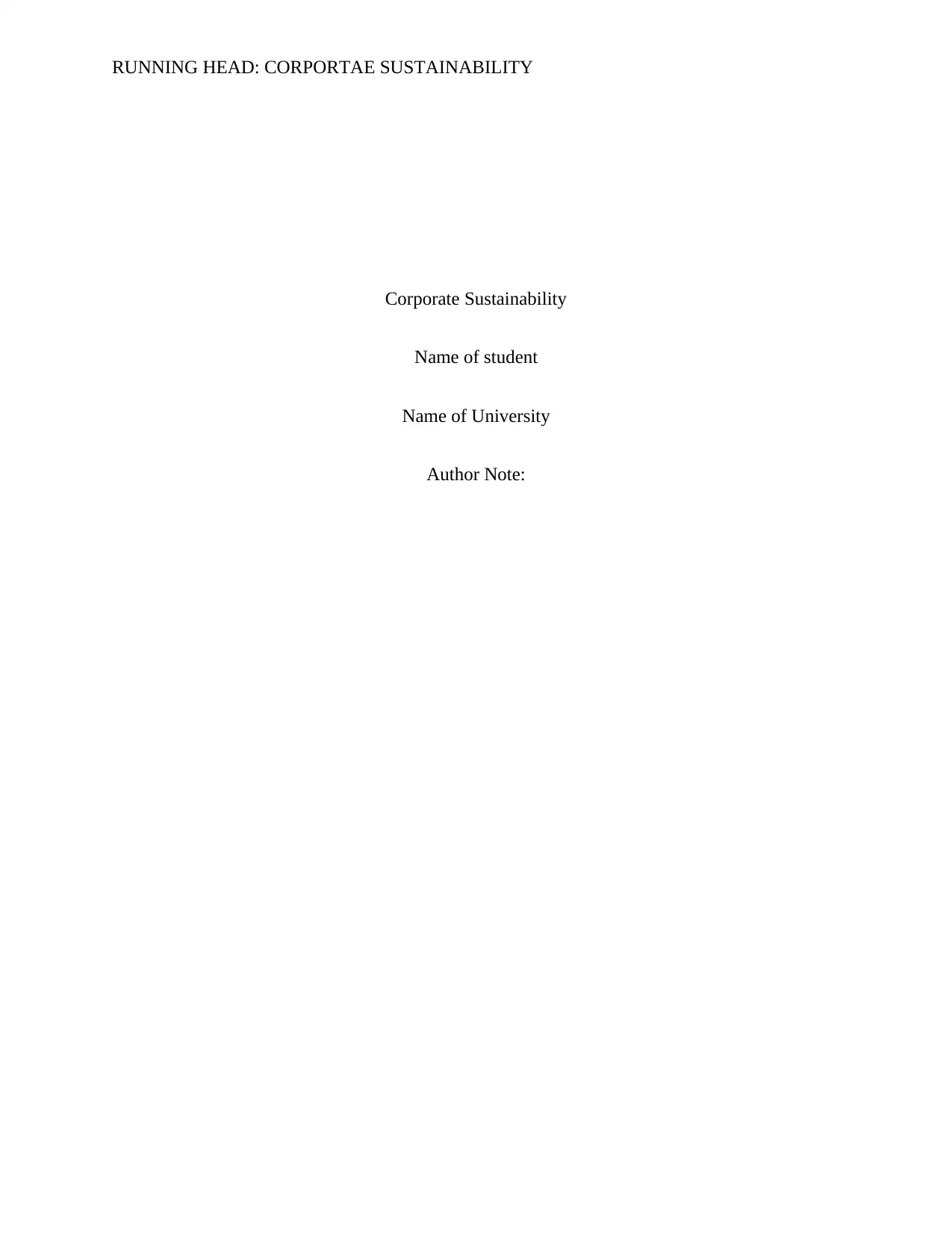
RUNNING HEAD: CORPORTAE SUSTAINABILITY
Corporate Sustainability
Name of student
Name of University
Author Note:
Corporate Sustainability
Name of student
Name of University
Author Note:
Paraphrase This Document
Need a fresh take? Get an instant paraphrase of this document with our AI Paraphraser
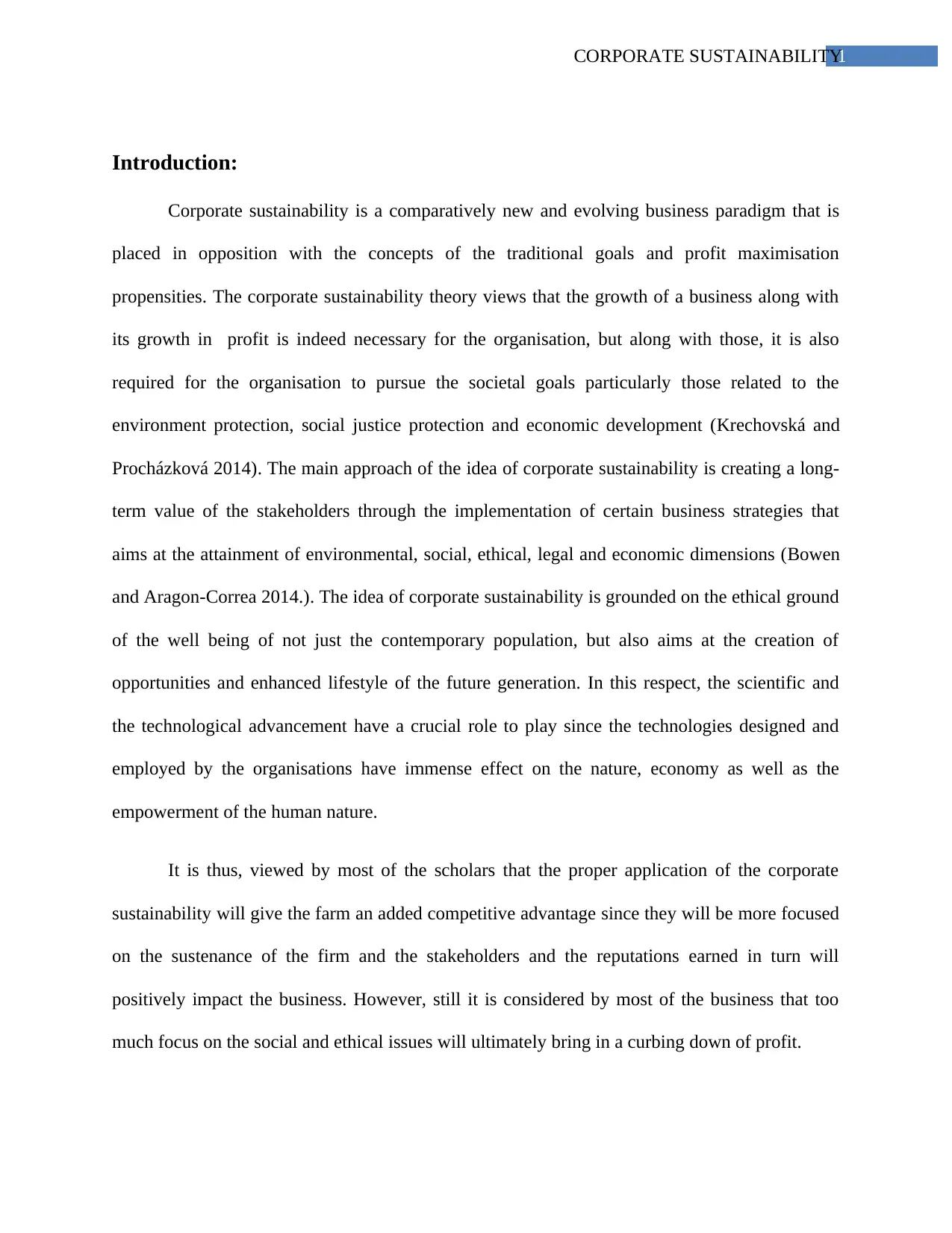
1CORPORATE SUSTAINABILITY
Introduction:
Corporate sustainability is a comparatively new and evolving business paradigm that is
placed in opposition with the concepts of the traditional goals and profit maximisation
propensities. The corporate sustainability theory views that the growth of a business along with
its growth in profit is indeed necessary for the organisation, but along with those, it is also
required for the organisation to pursue the societal goals particularly those related to the
environment protection, social justice protection and economic development (Krechovská and
Procházková 2014). The main approach of the idea of corporate sustainability is creating a long-
term value of the stakeholders through the implementation of certain business strategies that
aims at the attainment of environmental, social, ethical, legal and economic dimensions (Bowen
and Aragon-Correa 2014.). The idea of corporate sustainability is grounded on the ethical ground
of the well being of not just the contemporary population, but also aims at the creation of
opportunities and enhanced lifestyle of the future generation. In this respect, the scientific and
the technological advancement have a crucial role to play since the technologies designed and
employed by the organisations have immense effect on the nature, economy as well as the
empowerment of the human nature.
It is thus, viewed by most of the scholars that the proper application of the corporate
sustainability will give the farm an added competitive advantage since they will be more focused
on the sustenance of the firm and the stakeholders and the reputations earned in turn will
positively impact the business. However, still it is considered by most of the business that too
much focus on the social and ethical issues will ultimately bring in a curbing down of profit.
Introduction:
Corporate sustainability is a comparatively new and evolving business paradigm that is
placed in opposition with the concepts of the traditional goals and profit maximisation
propensities. The corporate sustainability theory views that the growth of a business along with
its growth in profit is indeed necessary for the organisation, but along with those, it is also
required for the organisation to pursue the societal goals particularly those related to the
environment protection, social justice protection and economic development (Krechovská and
Procházková 2014). The main approach of the idea of corporate sustainability is creating a long-
term value of the stakeholders through the implementation of certain business strategies that
aims at the attainment of environmental, social, ethical, legal and economic dimensions (Bowen
and Aragon-Correa 2014.). The idea of corporate sustainability is grounded on the ethical ground
of the well being of not just the contemporary population, but also aims at the creation of
opportunities and enhanced lifestyle of the future generation. In this respect, the scientific and
the technological advancement have a crucial role to play since the technologies designed and
employed by the organisations have immense effect on the nature, economy as well as the
empowerment of the human nature.
It is thus, viewed by most of the scholars that the proper application of the corporate
sustainability will give the farm an added competitive advantage since they will be more focused
on the sustenance of the firm and the stakeholders and the reputations earned in turn will
positively impact the business. However, still it is considered by most of the business that too
much focus on the social and ethical issues will ultimately bring in a curbing down of profit.
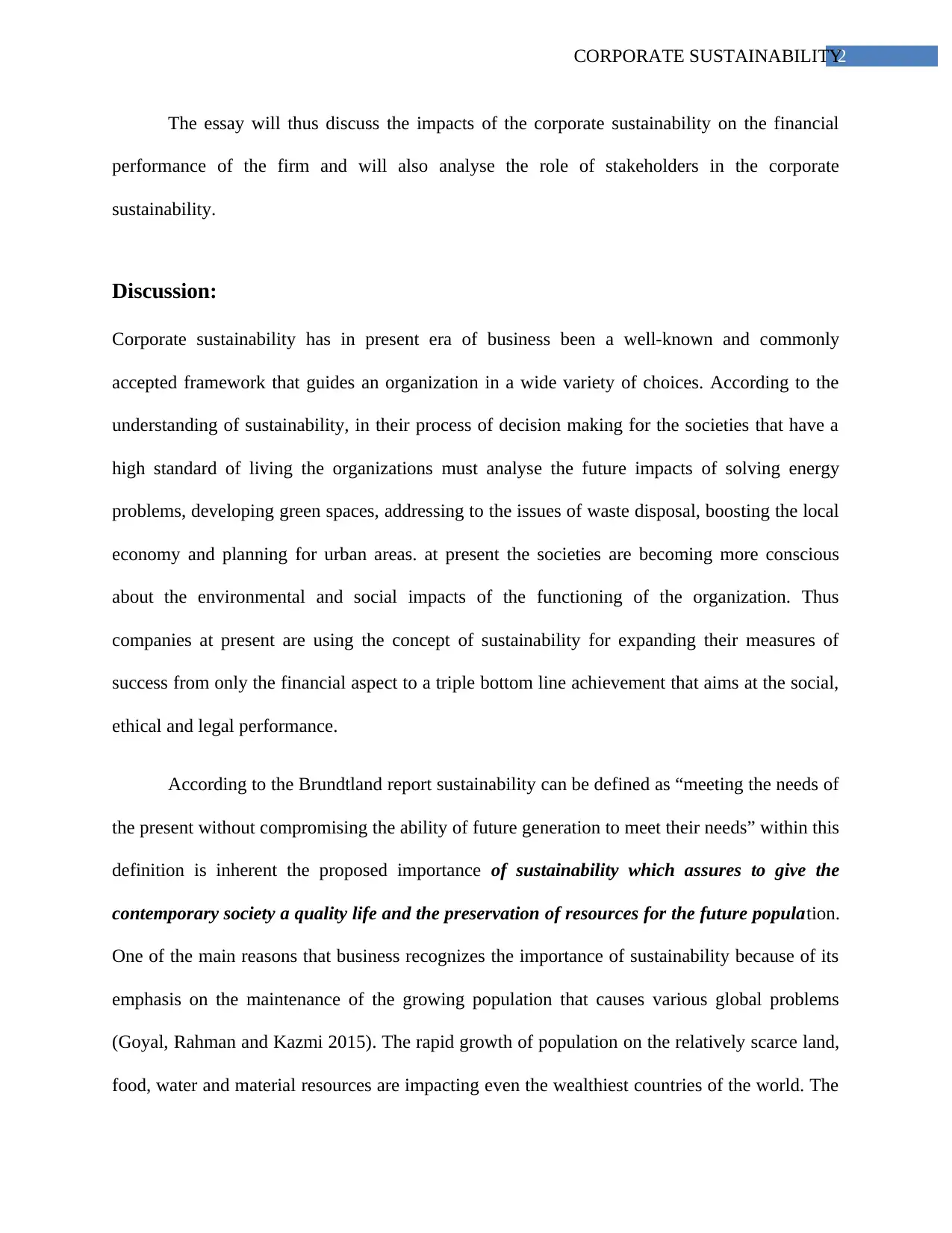
2CORPORATE SUSTAINABILITY
The essay will thus discuss the impacts of the corporate sustainability on the financial
performance of the firm and will also analyse the role of stakeholders in the corporate
sustainability.
Discussion:
Corporate sustainability has in present era of business been a well-known and commonly
accepted framework that guides an organization in a wide variety of choices. According to the
understanding of sustainability, in their process of decision making for the societies that have a
high standard of living the organizations must analyse the future impacts of solving energy
problems, developing green spaces, addressing to the issues of waste disposal, boosting the local
economy and planning for urban areas. at present the societies are becoming more conscious
about the environmental and social impacts of the functioning of the organization. Thus
companies at present are using the concept of sustainability for expanding their measures of
success from only the financial aspect to a triple bottom line achievement that aims at the social,
ethical and legal performance.
According to the Brundtland report sustainability can be defined as “meeting the needs of
the present without compromising the ability of future generation to meet their needs” within this
definition is inherent the proposed importance of sustainability which assures to give the
contemporary society a quality life and the preservation of resources for the future population.
One of the main reasons that business recognizes the importance of sustainability because of its
emphasis on the maintenance of the growing population that causes various global problems
(Goyal, Rahman and Kazmi 2015). The rapid growth of population on the relatively scarce land,
food, water and material resources are impacting even the wealthiest countries of the world. The
The essay will thus discuss the impacts of the corporate sustainability on the financial
performance of the firm and will also analyse the role of stakeholders in the corporate
sustainability.
Discussion:
Corporate sustainability has in present era of business been a well-known and commonly
accepted framework that guides an organization in a wide variety of choices. According to the
understanding of sustainability, in their process of decision making for the societies that have a
high standard of living the organizations must analyse the future impacts of solving energy
problems, developing green spaces, addressing to the issues of waste disposal, boosting the local
economy and planning for urban areas. at present the societies are becoming more conscious
about the environmental and social impacts of the functioning of the organization. Thus
companies at present are using the concept of sustainability for expanding their measures of
success from only the financial aspect to a triple bottom line achievement that aims at the social,
ethical and legal performance.
According to the Brundtland report sustainability can be defined as “meeting the needs of
the present without compromising the ability of future generation to meet their needs” within this
definition is inherent the proposed importance of sustainability which assures to give the
contemporary society a quality life and the preservation of resources for the future population.
One of the main reasons that business recognizes the importance of sustainability because of its
emphasis on the maintenance of the growing population that causes various global problems
(Goyal, Rahman and Kazmi 2015). The rapid growth of population on the relatively scarce land,
food, water and material resources are impacting even the wealthiest countries of the world. The
⊘ This is a preview!⊘
Do you want full access?
Subscribe today to unlock all pages.

Trusted by 1+ million students worldwide
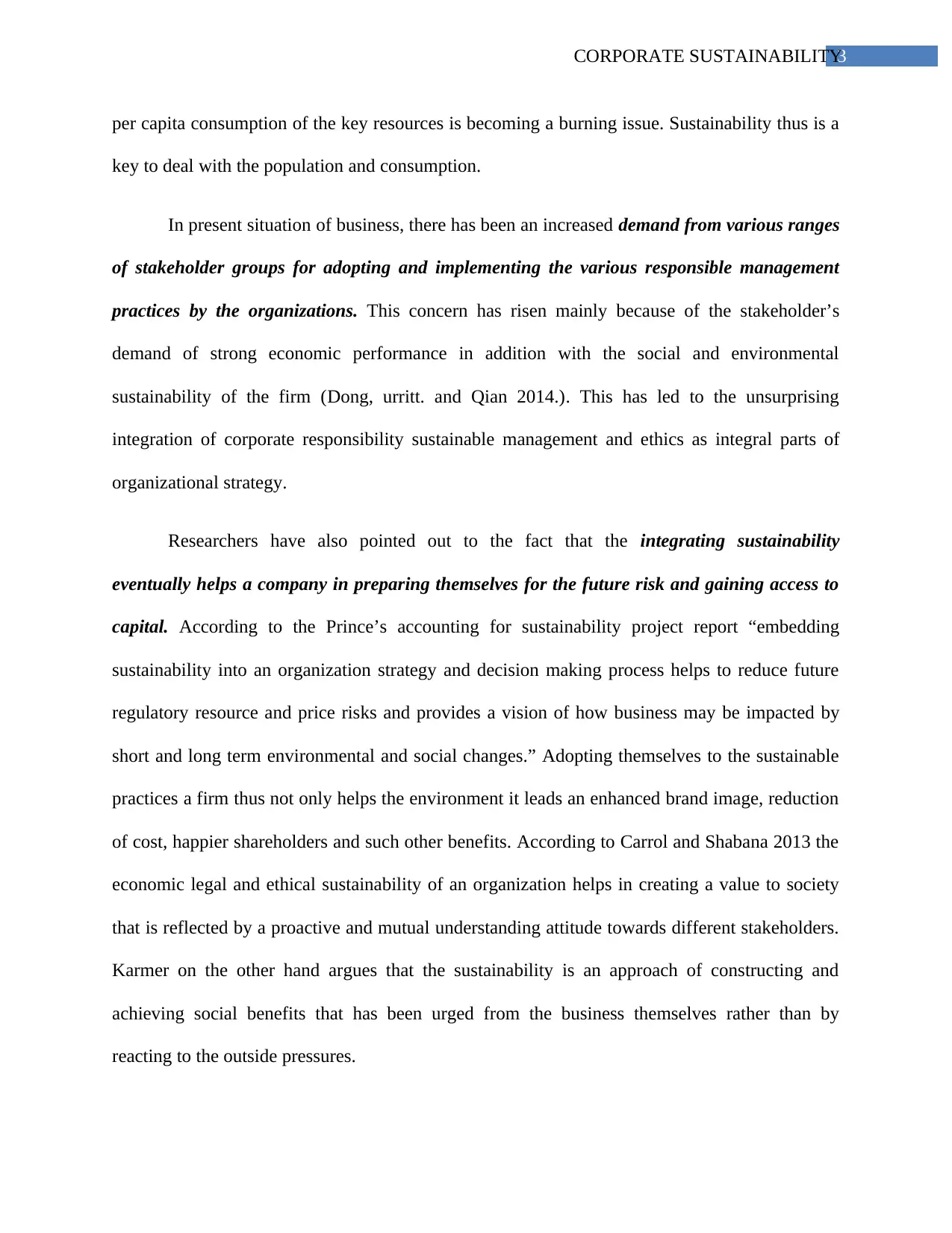
3CORPORATE SUSTAINABILITY
per capita consumption of the key resources is becoming a burning issue. Sustainability thus is a
key to deal with the population and consumption.
In present situation of business, there has been an increased demand from various ranges
of stakeholder groups for adopting and implementing the various responsible management
practices by the organizations. This concern has risen mainly because of the stakeholder’s
demand of strong economic performance in addition with the social and environmental
sustainability of the firm (Dong, urritt. and Qian 2014.). This has led to the unsurprising
integration of corporate responsibility sustainable management and ethics as integral parts of
organizational strategy.
Researchers have also pointed out to the fact that the integrating sustainability
eventually helps a company in preparing themselves for the future risk and gaining access to
capital. According to the Prince’s accounting for sustainability project report “embedding
sustainability into an organization strategy and decision making process helps to reduce future
regulatory resource and price risks and provides a vision of how business may be impacted by
short and long term environmental and social changes.” Adopting themselves to the sustainable
practices a firm thus not only helps the environment it leads an enhanced brand image, reduction
of cost, happier shareholders and such other benefits. According to Carrol and Shabana 2013 the
economic legal and ethical sustainability of an organization helps in creating a value to society
that is reflected by a proactive and mutual understanding attitude towards different stakeholders.
Karmer on the other hand argues that the sustainability is an approach of constructing and
achieving social benefits that has been urged from the business themselves rather than by
reacting to the outside pressures.
per capita consumption of the key resources is becoming a burning issue. Sustainability thus is a
key to deal with the population and consumption.
In present situation of business, there has been an increased demand from various ranges
of stakeholder groups for adopting and implementing the various responsible management
practices by the organizations. This concern has risen mainly because of the stakeholder’s
demand of strong economic performance in addition with the social and environmental
sustainability of the firm (Dong, urritt. and Qian 2014.). This has led to the unsurprising
integration of corporate responsibility sustainable management and ethics as integral parts of
organizational strategy.
Researchers have also pointed out to the fact that the integrating sustainability
eventually helps a company in preparing themselves for the future risk and gaining access to
capital. According to the Prince’s accounting for sustainability project report “embedding
sustainability into an organization strategy and decision making process helps to reduce future
regulatory resource and price risks and provides a vision of how business may be impacted by
short and long term environmental and social changes.” Adopting themselves to the sustainable
practices a firm thus not only helps the environment it leads an enhanced brand image, reduction
of cost, happier shareholders and such other benefits. According to Carrol and Shabana 2013 the
economic legal and ethical sustainability of an organization helps in creating a value to society
that is reflected by a proactive and mutual understanding attitude towards different stakeholders.
Karmer on the other hand argues that the sustainability is an approach of constructing and
achieving social benefits that has been urged from the business themselves rather than by
reacting to the outside pressures.
Paraphrase This Document
Need a fresh take? Get an instant paraphrase of this document with our AI Paraphraser
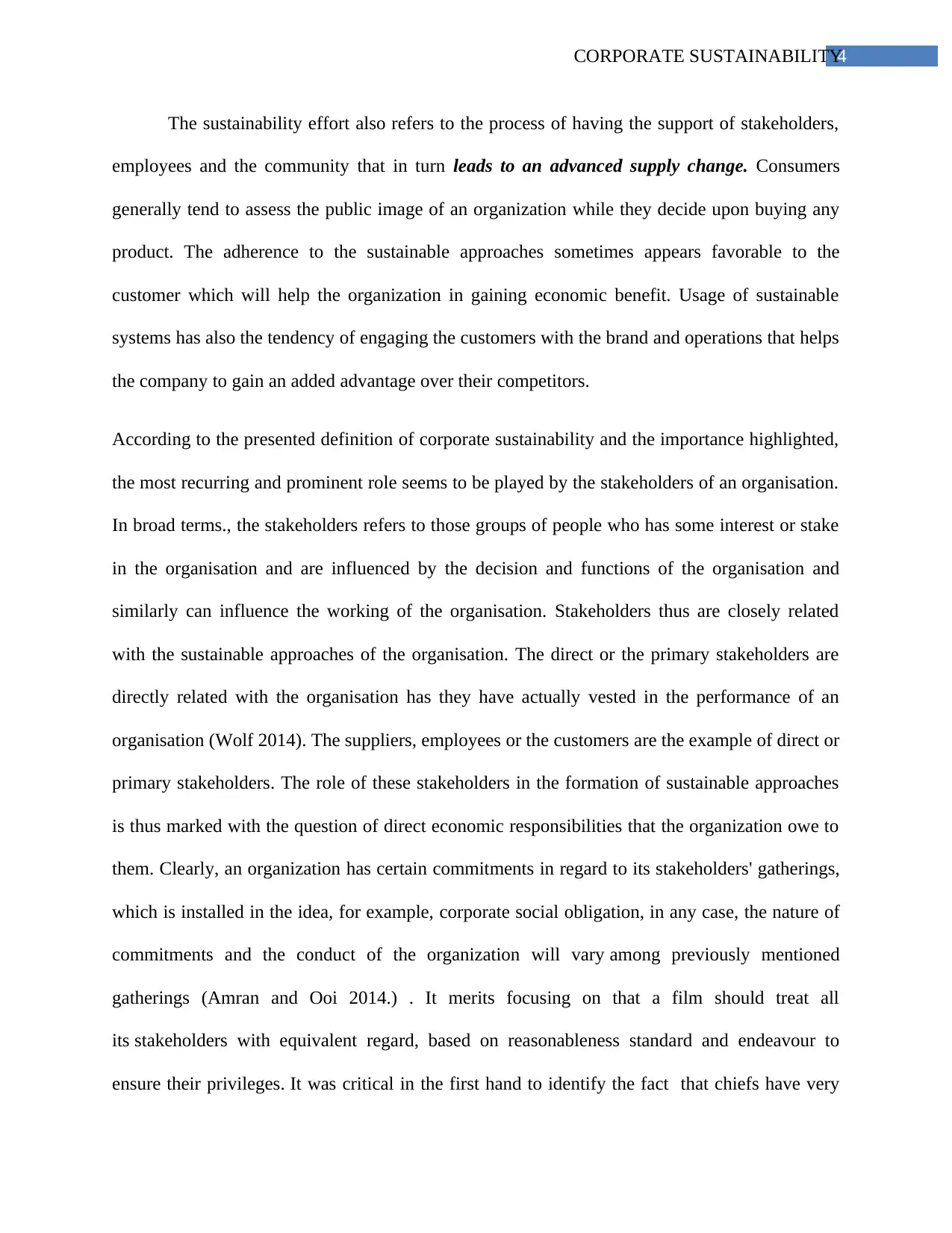
4CORPORATE SUSTAINABILITY
The sustainability effort also refers to the process of having the support of stakeholders,
employees and the community that in turn leads to an advanced supply change. Consumers
generally tend to assess the public image of an organization while they decide upon buying any
product. The adherence to the sustainable approaches sometimes appears favorable to the
customer which will help the organization in gaining economic benefit. Usage of sustainable
systems has also the tendency of engaging the customers with the brand and operations that helps
the company to gain an added advantage over their competitors.
According to the presented definition of corporate sustainability and the importance highlighted,
the most recurring and prominent role seems to be played by the stakeholders of an organisation.
In broad terms., the stakeholders refers to those groups of people who has some interest or stake
in the organisation and are influenced by the decision and functions of the organisation and
similarly can influence the working of the organisation. Stakeholders thus are closely related
with the sustainable approaches of the organisation. The direct or the primary stakeholders are
directly related with the organisation has they have actually vested in the performance of an
organisation (Wolf 2014). The suppliers, employees or the customers are the example of direct or
primary stakeholders. The role of these stakeholders in the formation of sustainable approaches
is thus marked with the question of direct economic responsibilities that the organization owe to
them. Clearly, an organization has certain commitments in regard to its stakeholders' gatherings,
which is installed in the idea, for example, corporate social obligation, in any case, the nature of
commitments and the conduct of the organization will vary among previously mentioned
gatherings (Amran and Ooi 2014.) . It merits focusing on that a film should treat all
its stakeholders with equivalent regard, based on reasonableness standard and endeavour to
ensure their privileges. It was critical in the first hand to identify the fact that chiefs have very
The sustainability effort also refers to the process of having the support of stakeholders,
employees and the community that in turn leads to an advanced supply change. Consumers
generally tend to assess the public image of an organization while they decide upon buying any
product. The adherence to the sustainable approaches sometimes appears favorable to the
customer which will help the organization in gaining economic benefit. Usage of sustainable
systems has also the tendency of engaging the customers with the brand and operations that helps
the company to gain an added advantage over their competitors.
According to the presented definition of corporate sustainability and the importance highlighted,
the most recurring and prominent role seems to be played by the stakeholders of an organisation.
In broad terms., the stakeholders refers to those groups of people who has some interest or stake
in the organisation and are influenced by the decision and functions of the organisation and
similarly can influence the working of the organisation. Stakeholders thus are closely related
with the sustainable approaches of the organisation. The direct or the primary stakeholders are
directly related with the organisation has they have actually vested in the performance of an
organisation (Wolf 2014). The suppliers, employees or the customers are the example of direct or
primary stakeholders. The role of these stakeholders in the formation of sustainable approaches
is thus marked with the question of direct economic responsibilities that the organization owe to
them. Clearly, an organization has certain commitments in regard to its stakeholders' gatherings,
which is installed in the idea, for example, corporate social obligation, in any case, the nature of
commitments and the conduct of the organization will vary among previously mentioned
gatherings (Amran and Ooi 2014.) . It merits focusing on that a film should treat all
its stakeholders with equivalent regard, based on reasonableness standard and endeavour to
ensure their privileges. It was critical in the first hand to identify the fact that chiefs have very
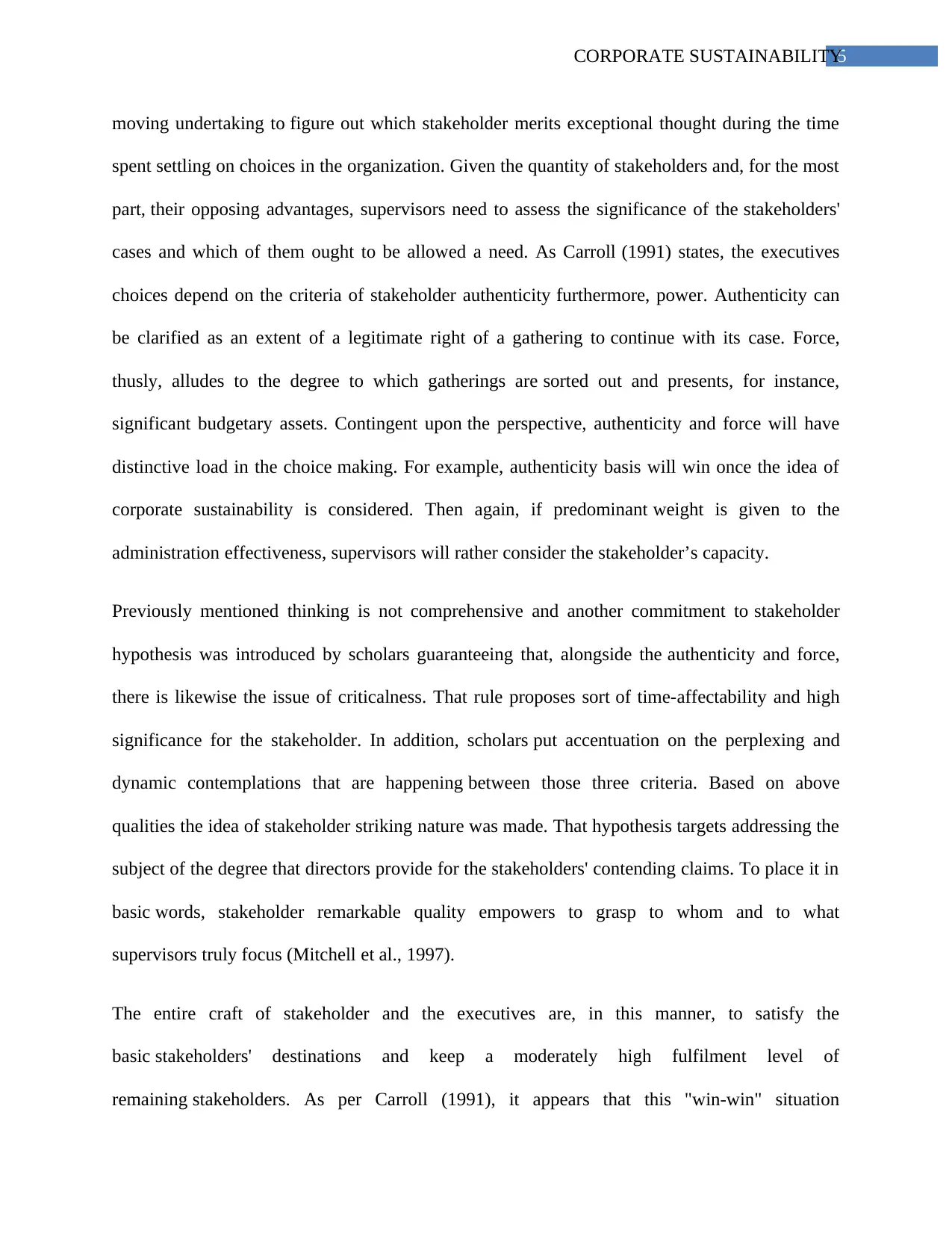
5CORPORATE SUSTAINABILITY
moving undertaking to figure out which stakeholder merits exceptional thought during the time
spent settling on choices in the organization. Given the quantity of stakeholders and, for the most
part, their opposing advantages, supervisors need to assess the significance of the stakeholders'
cases and which of them ought to be allowed a need. As Carroll (1991) states, the executives
choices depend on the criteria of stakeholder authenticity furthermore, power. Authenticity can
be clarified as an extent of a legitimate right of a gathering to continue with its case. Force,
thusly, alludes to the degree to which gatherings are sorted out and presents, for instance,
significant budgetary assets. Contingent upon the perspective, authenticity and force will have
distinctive load in the choice making. For example, authenticity basis will win once the idea of
corporate sustainability is considered. Then again, if predominant weight is given to the
administration effectiveness, supervisors will rather consider the stakeholder’s capacity.
Previously mentioned thinking is not comprehensive and another commitment to stakeholder
hypothesis was introduced by scholars guaranteeing that, alongside the authenticity and force,
there is likewise the issue of criticalness. That rule proposes sort of time-affectability and high
significance for the stakeholder. In addition, scholars put accentuation on the perplexing and
dynamic contemplations that are happening between those three criteria. Based on above
qualities the idea of stakeholder striking nature was made. That hypothesis targets addressing the
subject of the degree that directors provide for the stakeholders' contending claims. To place it in
basic words, stakeholder remarkable quality empowers to grasp to whom and to what
supervisors truly focus (Mitchell et al., 1997).
The entire craft of stakeholder and the executives are, in this manner, to satisfy the
basic stakeholders' destinations and keep a moderately high fulfilment level of
remaining stakeholders. As per Carroll (1991), it appears that this "win-win" situation
moving undertaking to figure out which stakeholder merits exceptional thought during the time
spent settling on choices in the organization. Given the quantity of stakeholders and, for the most
part, their opposing advantages, supervisors need to assess the significance of the stakeholders'
cases and which of them ought to be allowed a need. As Carroll (1991) states, the executives
choices depend on the criteria of stakeholder authenticity furthermore, power. Authenticity can
be clarified as an extent of a legitimate right of a gathering to continue with its case. Force,
thusly, alludes to the degree to which gatherings are sorted out and presents, for instance,
significant budgetary assets. Contingent upon the perspective, authenticity and force will have
distinctive load in the choice making. For example, authenticity basis will win once the idea of
corporate sustainability is considered. Then again, if predominant weight is given to the
administration effectiveness, supervisors will rather consider the stakeholder’s capacity.
Previously mentioned thinking is not comprehensive and another commitment to stakeholder
hypothesis was introduced by scholars guaranteeing that, alongside the authenticity and force,
there is likewise the issue of criticalness. That rule proposes sort of time-affectability and high
significance for the stakeholder. In addition, scholars put accentuation on the perplexing and
dynamic contemplations that are happening between those three criteria. Based on above
qualities the idea of stakeholder striking nature was made. That hypothesis targets addressing the
subject of the degree that directors provide for the stakeholders' contending claims. To place it in
basic words, stakeholder remarkable quality empowers to grasp to whom and to what
supervisors truly focus (Mitchell et al., 1997).
The entire craft of stakeholder and the executives are, in this manner, to satisfy the
basic stakeholders' destinations and keep a moderately high fulfilment level of
remaining stakeholders. As per Carroll (1991), it appears that this "win-win" situation
⊘ This is a preview!⊘
Do you want full access?
Subscribe today to unlock all pages.

Trusted by 1+ million students worldwide
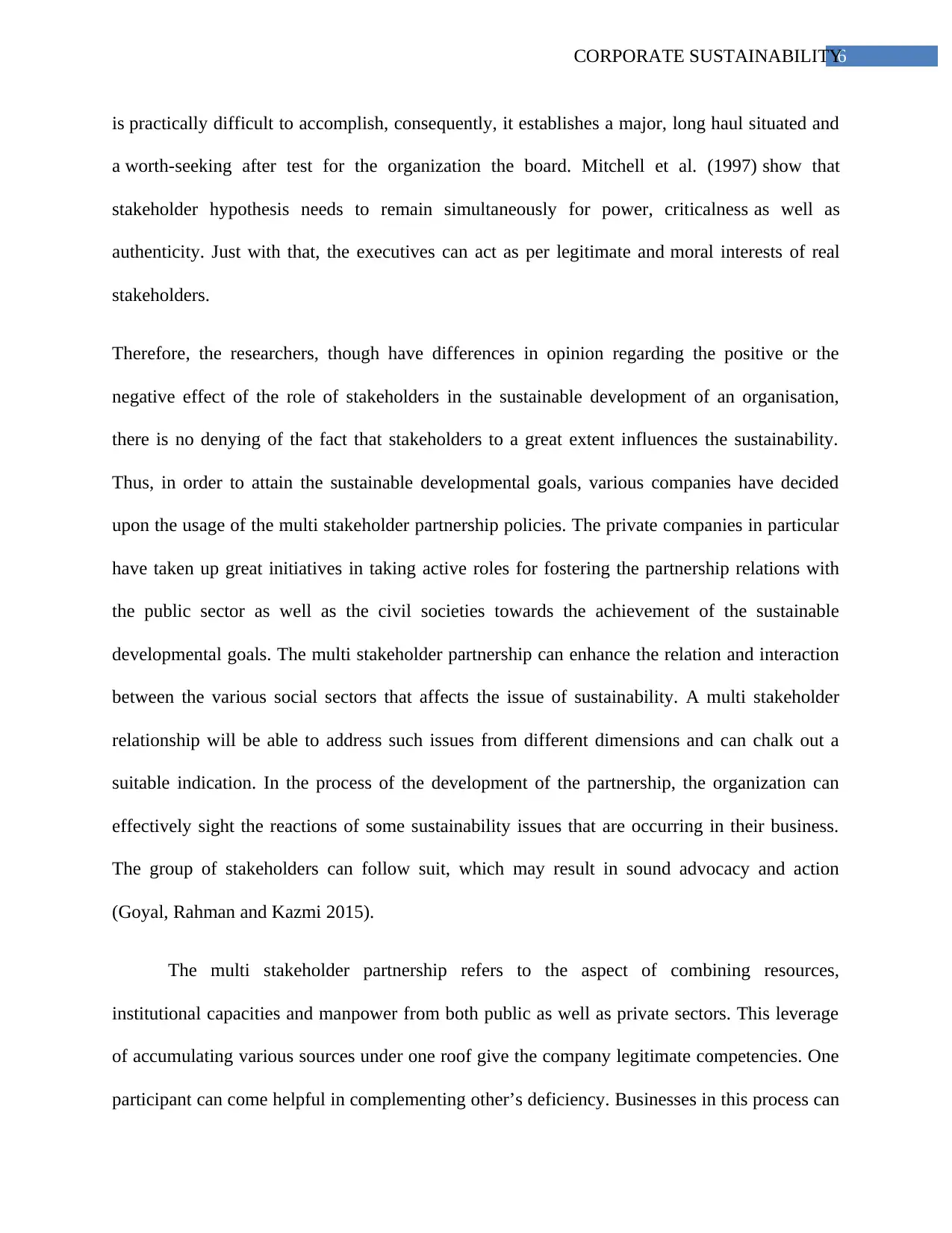
6CORPORATE SUSTAINABILITY
is practically difficult to accomplish, consequently, it establishes a major, long haul situated and
a worth-seeking after test for the organization the board. Mitchell et al. (1997) show that
stakeholder hypothesis needs to remain simultaneously for power, criticalness as well as
authenticity. Just with that, the executives can act as per legitimate and moral interests of real
stakeholders.
Therefore, the researchers, though have differences in opinion regarding the positive or the
negative effect of the role of stakeholders in the sustainable development of an organisation,
there is no denying of the fact that stakeholders to a great extent influences the sustainability.
Thus, in order to attain the sustainable developmental goals, various companies have decided
upon the usage of the multi stakeholder partnership policies. The private companies in particular
have taken up great initiatives in taking active roles for fostering the partnership relations with
the public sector as well as the civil societies towards the achievement of the sustainable
developmental goals. The multi stakeholder partnership can enhance the relation and interaction
between the various social sectors that affects the issue of sustainability. A multi stakeholder
relationship will be able to address such issues from different dimensions and can chalk out a
suitable indication. In the process of the development of the partnership, the organization can
effectively sight the reactions of some sustainability issues that are occurring in their business.
The group of stakeholders can follow suit, which may result in sound advocacy and action
(Goyal, Rahman and Kazmi 2015).
The multi stakeholder partnership refers to the aspect of combining resources,
institutional capacities and manpower from both public as well as private sectors. This leverage
of accumulating various sources under one roof give the company legitimate competencies. One
participant can come helpful in complementing other’s deficiency. Businesses in this process can
is practically difficult to accomplish, consequently, it establishes a major, long haul situated and
a worth-seeking after test for the organization the board. Mitchell et al. (1997) show that
stakeholder hypothesis needs to remain simultaneously for power, criticalness as well as
authenticity. Just with that, the executives can act as per legitimate and moral interests of real
stakeholders.
Therefore, the researchers, though have differences in opinion regarding the positive or the
negative effect of the role of stakeholders in the sustainable development of an organisation,
there is no denying of the fact that stakeholders to a great extent influences the sustainability.
Thus, in order to attain the sustainable developmental goals, various companies have decided
upon the usage of the multi stakeholder partnership policies. The private companies in particular
have taken up great initiatives in taking active roles for fostering the partnership relations with
the public sector as well as the civil societies towards the achievement of the sustainable
developmental goals. The multi stakeholder partnership can enhance the relation and interaction
between the various social sectors that affects the issue of sustainability. A multi stakeholder
relationship will be able to address such issues from different dimensions and can chalk out a
suitable indication. In the process of the development of the partnership, the organization can
effectively sight the reactions of some sustainability issues that are occurring in their business.
The group of stakeholders can follow suit, which may result in sound advocacy and action
(Goyal, Rahman and Kazmi 2015).
The multi stakeholder partnership refers to the aspect of combining resources,
institutional capacities and manpower from both public as well as private sectors. This leverage
of accumulating various sources under one roof give the company legitimate competencies. One
participant can come helpful in complementing other’s deficiency. Businesses in this process can
Paraphrase This Document
Need a fresh take? Get an instant paraphrase of this document with our AI Paraphraser
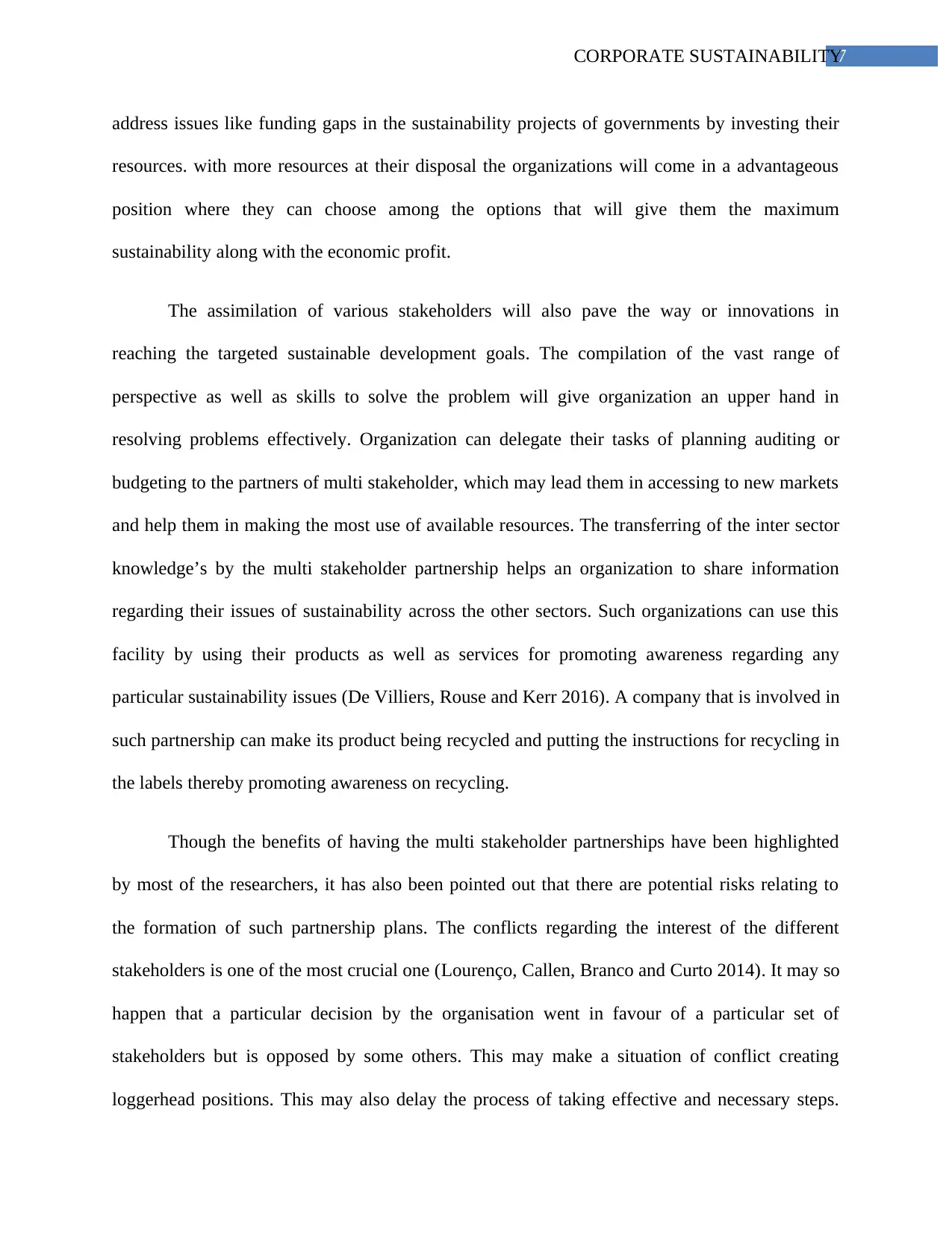
7CORPORATE SUSTAINABILITY
address issues like funding gaps in the sustainability projects of governments by investing their
resources. with more resources at their disposal the organizations will come in a advantageous
position where they can choose among the options that will give them the maximum
sustainability along with the economic profit.
The assimilation of various stakeholders will also pave the way or innovations in
reaching the targeted sustainable development goals. The compilation of the vast range of
perspective as well as skills to solve the problem will give organization an upper hand in
resolving problems effectively. Organization can delegate their tasks of planning auditing or
budgeting to the partners of multi stakeholder, which may lead them in accessing to new markets
and help them in making the most use of available resources. The transferring of the inter sector
knowledge’s by the multi stakeholder partnership helps an organization to share information
regarding their issues of sustainability across the other sectors. Such organizations can use this
facility by using their products as well as services for promoting awareness regarding any
particular sustainability issues (De Villiers, Rouse and Kerr 2016). A company that is involved in
such partnership can make its product being recycled and putting the instructions for recycling in
the labels thereby promoting awareness on recycling.
Though the benefits of having the multi stakeholder partnerships have been highlighted
by most of the researchers, it has also been pointed out that there are potential risks relating to
the formation of such partnership plans. The conflicts regarding the interest of the different
stakeholders is one of the most crucial one (Lourenço, Callen, Branco and Curto 2014). It may so
happen that a particular decision by the organisation went in favour of a particular set of
stakeholders but is opposed by some others. This may make a situation of conflict creating
loggerhead positions. This may also delay the process of taking effective and necessary steps.
address issues like funding gaps in the sustainability projects of governments by investing their
resources. with more resources at their disposal the organizations will come in a advantageous
position where they can choose among the options that will give them the maximum
sustainability along with the economic profit.
The assimilation of various stakeholders will also pave the way or innovations in
reaching the targeted sustainable development goals. The compilation of the vast range of
perspective as well as skills to solve the problem will give organization an upper hand in
resolving problems effectively. Organization can delegate their tasks of planning auditing or
budgeting to the partners of multi stakeholder, which may lead them in accessing to new markets
and help them in making the most use of available resources. The transferring of the inter sector
knowledge’s by the multi stakeholder partnership helps an organization to share information
regarding their issues of sustainability across the other sectors. Such organizations can use this
facility by using their products as well as services for promoting awareness regarding any
particular sustainability issues (De Villiers, Rouse and Kerr 2016). A company that is involved in
such partnership can make its product being recycled and putting the instructions for recycling in
the labels thereby promoting awareness on recycling.
Though the benefits of having the multi stakeholder partnerships have been highlighted
by most of the researchers, it has also been pointed out that there are potential risks relating to
the formation of such partnership plans. The conflicts regarding the interest of the different
stakeholders is one of the most crucial one (Lourenço, Callen, Branco and Curto 2014). It may so
happen that a particular decision by the organisation went in favour of a particular set of
stakeholders but is opposed by some others. This may make a situation of conflict creating
loggerhead positions. This may also delay the process of taking effective and necessary steps.
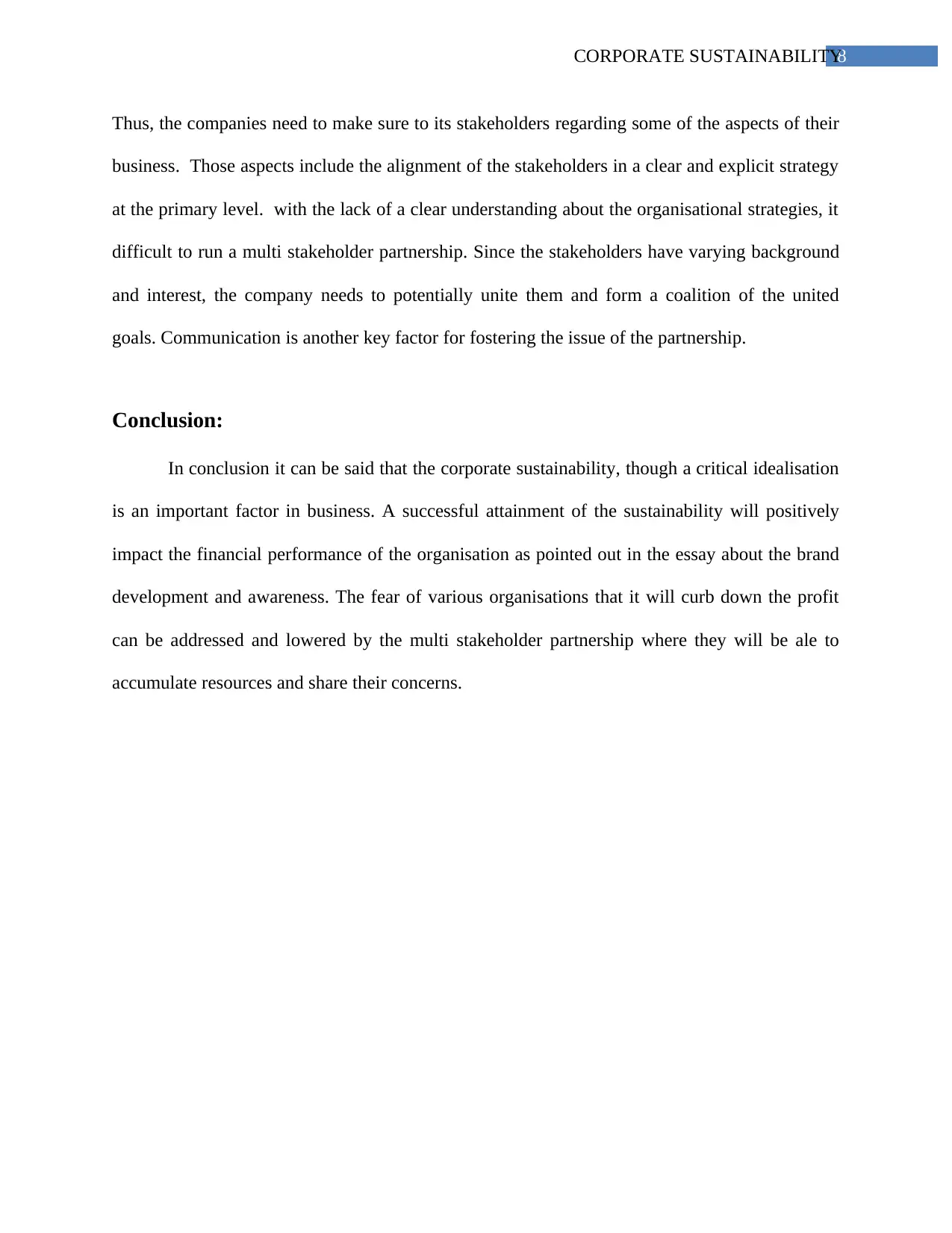
8CORPORATE SUSTAINABILITY
Thus, the companies need to make sure to its stakeholders regarding some of the aspects of their
business. Those aspects include the alignment of the stakeholders in a clear and explicit strategy
at the primary level. with the lack of a clear understanding about the organisational strategies, it
difficult to run a multi stakeholder partnership. Since the stakeholders have varying background
and interest, the company needs to potentially unite them and form a coalition of the united
goals. Communication is another key factor for fostering the issue of the partnership.
Conclusion:
In conclusion it can be said that the corporate sustainability, though a critical idealisation
is an important factor in business. A successful attainment of the sustainability will positively
impact the financial performance of the organisation as pointed out in the essay about the brand
development and awareness. The fear of various organisations that it will curb down the profit
can be addressed and lowered by the multi stakeholder partnership where they will be ale to
accumulate resources and share their concerns.
Thus, the companies need to make sure to its stakeholders regarding some of the aspects of their
business. Those aspects include the alignment of the stakeholders in a clear and explicit strategy
at the primary level. with the lack of a clear understanding about the organisational strategies, it
difficult to run a multi stakeholder partnership. Since the stakeholders have varying background
and interest, the company needs to potentially unite them and form a coalition of the united
goals. Communication is another key factor for fostering the issue of the partnership.
Conclusion:
In conclusion it can be said that the corporate sustainability, though a critical idealisation
is an important factor in business. A successful attainment of the sustainability will positively
impact the financial performance of the organisation as pointed out in the essay about the brand
development and awareness. The fear of various organisations that it will curb down the profit
can be addressed and lowered by the multi stakeholder partnership where they will be ale to
accumulate resources and share their concerns.
⊘ This is a preview!⊘
Do you want full access?
Subscribe today to unlock all pages.

Trusted by 1+ million students worldwide
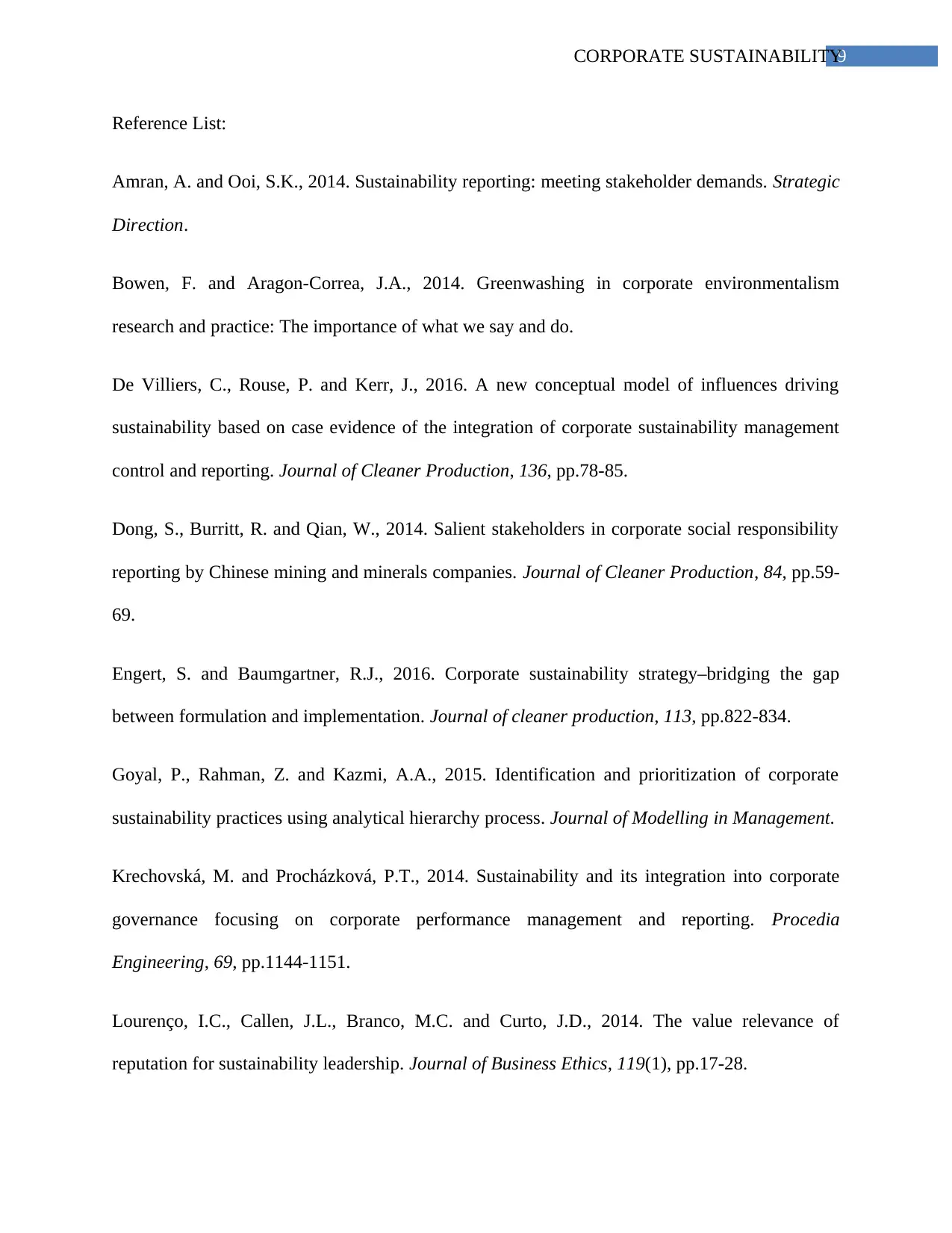
9CORPORATE SUSTAINABILITY
Reference List:
Amran, A. and Ooi, S.K., 2014. Sustainability reporting: meeting stakeholder demands. Strategic
Direction.
Bowen, F. and Aragon-Correa, J.A., 2014. Greenwashing in corporate environmentalism
research and practice: The importance of what we say and do.
De Villiers, C., Rouse, P. and Kerr, J., 2016. A new conceptual model of influences driving
sustainability based on case evidence of the integration of corporate sustainability management
control and reporting. Journal of Cleaner Production, 136, pp.78-85.
Dong, S., Burritt, R. and Qian, W., 2014. Salient stakeholders in corporate social responsibility
reporting by Chinese mining and minerals companies. Journal of Cleaner Production, 84, pp.59-
69.
Engert, S. and Baumgartner, R.J., 2016. Corporate sustainability strategy–bridging the gap
between formulation and implementation. Journal of cleaner production, 113, pp.822-834.
Goyal, P., Rahman, Z. and Kazmi, A.A., 2015. Identification and prioritization of corporate
sustainability practices using analytical hierarchy process. Journal of Modelling in Management.
Krechovská, M. and Procházková, P.T., 2014. Sustainability and its integration into corporate
governance focusing on corporate performance management and reporting. Procedia
Engineering, 69, pp.1144-1151.
Lourenço, I.C., Callen, J.L., Branco, M.C. and Curto, J.D., 2014. The value relevance of
reputation for sustainability leadership. Journal of Business Ethics, 119(1), pp.17-28.
Reference List:
Amran, A. and Ooi, S.K., 2014. Sustainability reporting: meeting stakeholder demands. Strategic
Direction.
Bowen, F. and Aragon-Correa, J.A., 2014. Greenwashing in corporate environmentalism
research and practice: The importance of what we say and do.
De Villiers, C., Rouse, P. and Kerr, J., 2016. A new conceptual model of influences driving
sustainability based on case evidence of the integration of corporate sustainability management
control and reporting. Journal of Cleaner Production, 136, pp.78-85.
Dong, S., Burritt, R. and Qian, W., 2014. Salient stakeholders in corporate social responsibility
reporting by Chinese mining and minerals companies. Journal of Cleaner Production, 84, pp.59-
69.
Engert, S. and Baumgartner, R.J., 2016. Corporate sustainability strategy–bridging the gap
between formulation and implementation. Journal of cleaner production, 113, pp.822-834.
Goyal, P., Rahman, Z. and Kazmi, A.A., 2015. Identification and prioritization of corporate
sustainability practices using analytical hierarchy process. Journal of Modelling in Management.
Krechovská, M. and Procházková, P.T., 2014. Sustainability and its integration into corporate
governance focusing on corporate performance management and reporting. Procedia
Engineering, 69, pp.1144-1151.
Lourenço, I.C., Callen, J.L., Branco, M.C. and Curto, J.D., 2014. The value relevance of
reputation for sustainability leadership. Journal of Business Ethics, 119(1), pp.17-28.
Paraphrase This Document
Need a fresh take? Get an instant paraphrase of this document with our AI Paraphraser
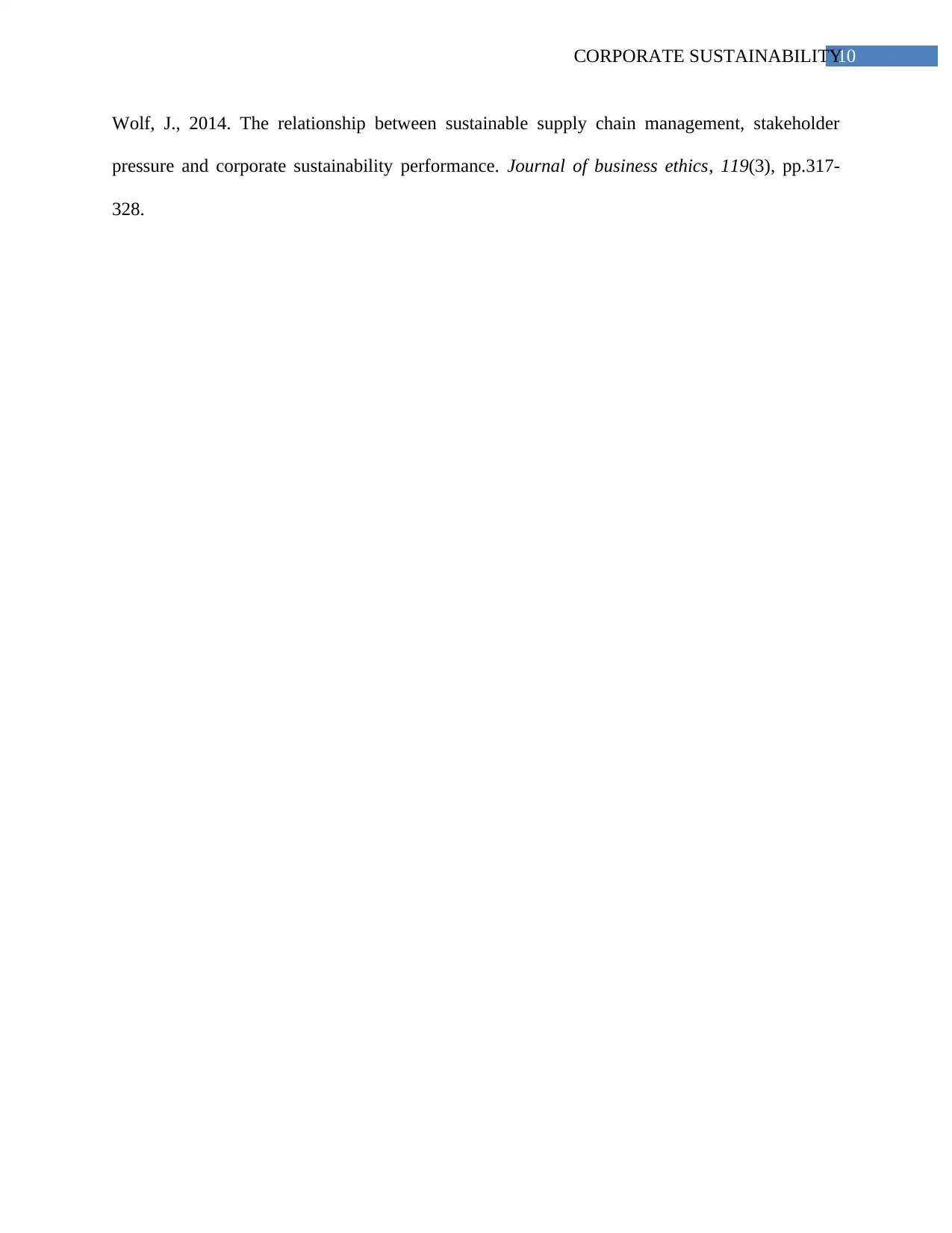
10CORPORATE SUSTAINABILITY
Wolf, J., 2014. The relationship between sustainable supply chain management, stakeholder
pressure and corporate sustainability performance. Journal of business ethics, 119(3), pp.317-
328.
Wolf, J., 2014. The relationship between sustainable supply chain management, stakeholder
pressure and corporate sustainability performance. Journal of business ethics, 119(3), pp.317-
328.
1 out of 11
Related Documents
Your All-in-One AI-Powered Toolkit for Academic Success.
+13062052269
info@desklib.com
Available 24*7 on WhatsApp / Email
![[object Object]](/_next/static/media/star-bottom.7253800d.svg)
Unlock your academic potential
Copyright © 2020–2025 A2Z Services. All Rights Reserved. Developed and managed by ZUCOL.





